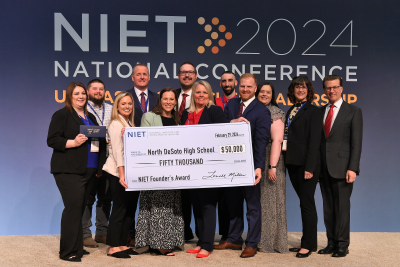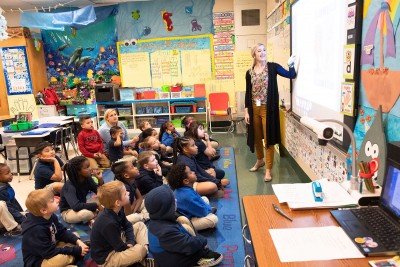Equity for Refugee Students
Perry Township, Indiana | 2019

The Scene
Over the past decade, Perry Township in Indianapolis has seen significant increases in refugee students and English Learners (ELs), and now has the highest percentage of ELs in the state. Perry's students speak a total of 73 languages, ranging from Swahili to Burmese, and nearly two-thirds of its ELs are refugee students.
The influx of refugees over the past five years has largely contributed to Perry's position as the second-fastest growing district in Indiana. In addition, the percentage of students eligible for free or reduced-priced lunch increased from 61% in 2013-14 to 71% in 2018-19.
Perry Township has met this challenge head on by better supporting its educators through systems of professional learning led by teacher leaders, which has equipped educators to meet diverse student needs. Through these supports, Perry Township has achieved significant academic growth for all their students, but especially for its ELs who pass math and reading state tests at higher rates than comparable schools.
This case study looks at the impact of Perry's districtwide efforts through Mary Bryan Elementary School.
The Challenge
During the initial waves of newly resettled ELs, schools across Perry responded the best they could by offering supports to ELs that supplemented general instruction, most commonly through pull-out instruction or additional learning opportunities like after-school tutoring. They also began offering professional development in Sheltered Instruction for ELs and worked to implement the Sheltered Instruction Observation Protocol (SIOP) to measure teacher effectiveness with ELs.
Yet, Mary Bryan and other schools in Perry found their well-intentioned support for ELs actually limited learning opportunities for ELs and failed to raise student achievement. The pull-out approach created unnecessary segregation in the schools and caused general education teachers to hold different academic expectations for ELs compared to English-proficient counterparts. While professional development on how to teach ELs was offered through occasional workshops and trainings, teachers had no real support in effectively applying these strategies.
The New Approach
In 2012, Perry adopted the NIET Teaching Standards rubric and implemented a cohesive system of professional learning led by principals and teacher leaders across most schools in the district. As Perry's experience bore out, the sum of professional learning communities, strong instructional leadership teams, and effective coaching—when built into the structure of the school day—provided the scaffolding and support to help general education teachers become effective EL instructors.
Investing in a System of Professional Learning
The effort to provide equitable instruction for all students, including ELs, started with expanding the instructional leadership team. Perry elevated highly effective teachers in the building to teacher leader positions that had clear responsibilities and authority to lead instructional improvement strategies alongside the principal. Teacher leaders were included on the school instructional leadership team, who met weekly to monitor student progress and teacher growth. At Mary Bryan, the leadership team instituted a monthly staffwide "achievement meeting" run by the principal for teachers to examine data and set individual teacher- and grade-level goals. Leadership was also responsible for setting up trainings to help teachers develop strong foundational knowledge about effective instruction for ELs. Early in the year, teachers participated in crosswalks to understand how the Sheltered English Instruction Protocol aligned to the NIET Instructional Rubric and the school’s curricula.
With the leadership team setting the broad strategies, weekly PLCs led by teacher leaders became the key mechanism for supporting teachers.
Setting High Expectations and Providing Effective Supports for Student Communication
In their initial classroom walk-throughs, teacher leaders at Mary Bryan noticed that EL students struggled to use academic language and full sentences when communicating in class. To address this need, teacher leaders devoted a multiweek PLC cycle to teacher expectations for student communication in class around three focus areas: student body language, use of academic language, and confidence in asking for clarification. Teacher leaders worked with teachers on how to set student expectations around body language and how students should ask for clarification.
Once given the right supports, students starting responding and demonstrating knowledge in ways that often surprised teachers. Seeing the difference in student engagement, when combined with the improved quality of student work, provided teachers with small but significant wins that reinforced a schoolwide belief that all students can learn. As students began improving their communication skills and felt more engaged in class, the PLCs began to focus on building thinking and problem-solving skills.
Creating an Inclusive Culture for English Learners and All Students
To help build positive momentum and foster a sense of trust between the school leadership and classroom teachers, teacher leaders frequently recognized excellent instruction and student work. Focusing on student work became the locus of trust building not only between school leadership and teachers, but also between the students and teachers. As a result of the increased academic expectations and attention paid to their work, students began to sense that their teachers understood their needs and expected the best of them. This served as the foundation for helping students of all backgrounds feel cared for and included in the school community.
Mary Bryan Master Teacher Jennifer Dishman says there is so much support for everyone that "English Learners don’t recognize that they are different."
The Results
By implementing strong systems of professional learning, Mary Bryan and schools across Perry Township have created inclusive communities where ELs are growing academically. Exemplifying Perry's approach to providing equitable education for ELs, Assistant Superintendent Vickie Carpenter says, "We don’t see them as English Learners—they are just our kids." And this pursuit of equity has already paid off. According to spring 2018’s World-Class Instructional Design and Assessment (WIDA)—which measures multilingual readers—47% of Perry’s English Learners read at a Level 5, the most proficient level. This represents a 21% increase over the previous year.
More importantly, Perry’s investment in professional learning has led to academic gains for all students. Between 2015-16 and 2017-18, Perry Township students increased their passing rate on the ISTEP+ state assessment from 49.1% to 51.3%, effectively closing the gap with the state. In 2017-18, Perry’s passing rate surpassed that of the state. District graduation rates increased from 92.3% in 2014-15 to 94.2% in 2017-18, easily surpassing the 2017-18 state average of 88.1%.
These remarkable accomplishments have been achieved through school-based structures that support teacher and student growth. "NIET's framework is a game-changer for our district," noted Perry Township Schools Superintendent Pat Mapes. "It confirms that success is achieved when educators are trained to adapt their teaching methods to reach children regardless of nationality, socioeconomic background, learning disabilities, and personal challenges. NIET has empowered our educators to give their very best and be a catalyst for students to do their best."
Read about Perry Township Schools and its 2018 NIET National Award of Excellence for Educator Effectiveness.



